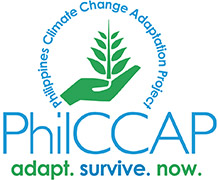Agencies set new activities, new targets
 |
| Graphical representation by Horace Cimafranca |
With less than a year remaining before its scheduled culmination, PhilCCAP is pushing for an extension of 18 months, not only to secure the completion of its activities and achieve full utilization of the World Bank grant, but also to accommodate opportunities that come with an extended implementation period.
In accordance with the Bank’s procedures, a so-called Extension Mission was held at the Department of Environment and Natural Resouces (DENR) office in Manila, led by the World Bank’s, Mr. Maurice Rawlins. An environment management specialist for the Bank, Mr. Rawlins will also be writing the restructuring plan, a document containing the details of the proposed extension of the project.
The purpose of the mission is to identify the reasons that pushed the project to request for extension, as well as discuss the new targets each agency will be setting should such extension was to be approved.
The mission began on February 18 with a courtesy call at the DENR attended by several representatives from PhilCCAP’s partner agencies, which include the Climate Change Commission (CCC), the Bureau of Soils and Water Management (BSWM), the Agricultural Training Institute (ATI), and the Philippine Crop Insurance Corporation (PCIC). Members of the Philippine Atmospheric, Geophysical and Astronomical Services Administration (PAGASA) were also present.
During the courtesy call, a short briefing on the current status of the Project was delivered by the World Bank’s Task Team Leader for PhilCCAP, Mr. Leonardo Paat, Jr. The report stressed that while some of the project’s outputs have been achieved, such as the feasibility study on the retrofitting of the Pinacanauan River Irrigation System in Cagayan province, reaching the project’s other targets remains largely dependent on the completion of other activities, which in turn require additional time.
A preliminary monitoring and evaluation report submitted by PhilCCAP’s consultant, Jourvin Barrera, for 2014, reveals that the project has achieved about seven-tenths of its objectives, but the project management office (PMO) is certain that the remaining targets are difficult to accomplish with less than a year remaining.
However, the proposal to extend the project was also largely pushed by the opportunities that surfaced while exploring the possibility of an extension. Several agencies are now expected to capitalize on the extra time, identifying new activities and targets to secure the success of their respective outputs and further improve the effectiveness of these deliverables.
In particular, the CCC, BSWM and ATI are pushing for the implementation of a communication strategy for the extension as a follow through activity for their respective outputs – the policy recommendation paper and the Enhanced Climate Smart Farmers Field School Manual, both of which are expected to be launched this year.
A communication strategy is expected to strengthen the resolve of these agencies to have their outputs adopted by various stakeholders, which include national government agencies, local government units and farmers. The PCIC will use the extension period to develop wind speed and flood indices for its crop insurance scheme.
PAGASA is looking to develop Climate Futures Tools, including an online database of projection maps that is seen to help LGUs consider future climatological conditions in planning, and climate field schools where capacity-building trainings on the use of PAGASA data will be conducted.
In addition, the extension will provide time for follow up activities involving the implementation of management plans for the protected areas of Peñablanca in Cagayan and Siargao Island in Surigao del Norte.
The extension is expected to begin in January 2016, with the new culmination date being reset to the middle of 2017. The mission was wrapped up last March 5, and it will take at least a month for the proposal for extension to be approved.


